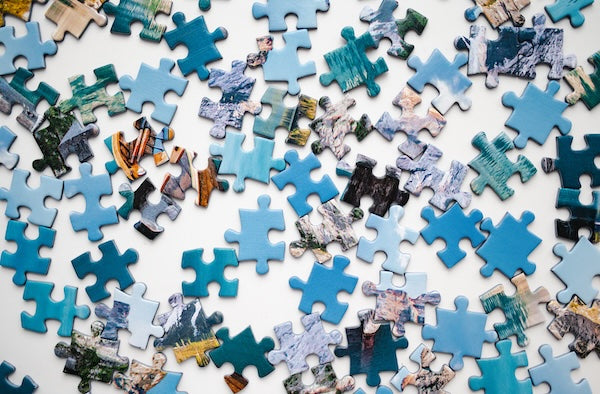The Differences in Jigsaw Puzzle Cuts: Ribbon vs Random

If you’ve ever delved into the world of jigsaw puzzles, you know they come in many shapes and sizes, with varying degrees of difficulty. What you may not have realized is that the way puzzles are cut plays a major role in the overall experience. While puzzle artwork and piece count are key factors, the cutting method directly affects how pieces fit together, how unique they are, and how satisfying the solving process can be.
In this blog post, we'll dive into the most common jigsaw puzzle cutting techniques and how each impacts your puzzling experience.
1. Ribbon Cut Puzzles

The ribbon cut is the traditional and most common method for jigsaw puzzle cutting. If you’ve ever completed a puzzle, especially one from Galison, chances are you’ve encountered a ribbon-cut puzzle.
Characteristics:
- Straight lines: The puzzle pieces are cut in straight rows and columns, giving a grid-like appearance.
- Uniform piece shapes: Most pieces have a similar basic shape: two knobs and two holes (sometimes called tabs and blanks).
- Predictable fits: The pieces follow a predictable interlocking pattern, making it easier to find matching pieces by their shape.
Advantages:
- Simplifies edge identification: With straight edges along rows and columns, ribbon-cut puzzles are easy to frame and assemble around the edges.
- Great for beginners: This method is ideal for those new to puzzles or looking for a straightforward, relaxing experience.
- Cleaner piece cuts: The uniformity ensures that pieces fit snugly and firmly.
Disadvantages:
- Repetitive shapes: Because the pieces are similar in shape, solving can become monotonous.
- Easy misfits: Pieces with nearly identical cuts can occasionally fit where they don’t belong, causing confusion.
2. Random Cut Puzzles

As the name suggests, random cut puzzles break free from the uniformity of ribbon cuts. Galison has a wide variety of random cut puzzles to challenge even the best puzzler.
Characteristics:
- Irregular shapes: Pieces come in varying, unpredictable forms—some with odd curves, asymmetrical knobs, or completely unique profiles.
- Unique fits: Each piece fits in only one place, thanks to its irregularity, making it harder to misplace pieces.
- Freeform edges: The puzzle may have wavy, jagged, or non-linear outer edges that break from the rectangular mold.
Advantages:
- Challenging and fun: The unpredictable nature of the pieces can add to the challenge and create a more rewarding experience when pieces finally fit.
- Fewer misfits: Due to their distinct shapes, pieces are less likely to fit incorrectly.
- Visually diverse: The wide range of piece shapes adds an extra layer of visual appeal to the puzzle, making it more interesting to assemble.
Disadvantages:
- Harder to sort: The lack of uniformity can make sorting and organizing pieces by shape more difficult.
- Less predictable: Some puzzlers may find it frustrating to work with pieces that don’t follow the standard shape conventions.
3. Laser-Cut Puzzles

A newer, more precise technology in puzzle making is laser cutting. This method involves cutting puzzle pieces with lasers instead of traditional metal dies, resulting in exceptionally clean and intricate cuts.
Characteristics:
- Precision cutting: Lasers create detailed, sharp-edged pieces with little to no fraying.
- High customization: This method allows for highly customized puzzles, often with unusual shapes, themes, or even personalized pieces.
- Wood or acrylic pieces: Laser-cut puzzles are often made from wood or acrylic rather than cardboard, offering a more durable and upscale feel.
Advantages:
- Precision fit: Pieces fit together perfectly without the slight looseness you might find in die-cut puzzles.
- Durability: The thicker materials used for laser-cut puzzles tend to last much longer, making them more of an investment piece.
- Artistic quality: Laser-cutting enables intricate designs, sometimes even producing pieces shaped like animals, objects, or symbols.
Disadvantages:
- Pricey: Laser-cut puzzles tend to be more expensive due to the high cost of production and materials.
- Harder to find: While growing in popularity, laser-cut puzzles are still less common than die-cut options, limiting availability.
Which Cutting Style is Right for You?
Choosing the right puzzle cutting style depends on your preferences and skill level:
- Beginner or casual puzzlers may prefer the straightforward nature of ribbon-cut puzzles.
- Experienced puzzlers looking for a challenge might enjoy the complexity of random-cut puzzles.
- Collectors or those seeking an artistic experience might gravitate toward premium laser-cut wooden or acrylic puzzles.
Understanding these cutting styles can make your next puzzle-buying experience more informed, ensuring you pick a puzzle that offers the right level of enjoyment and challenge for you. Whether you prefer the neat lines of a ribbon cut or the creative chaos of random cuts, there’s a puzzle out there that’s perfect for your style!





